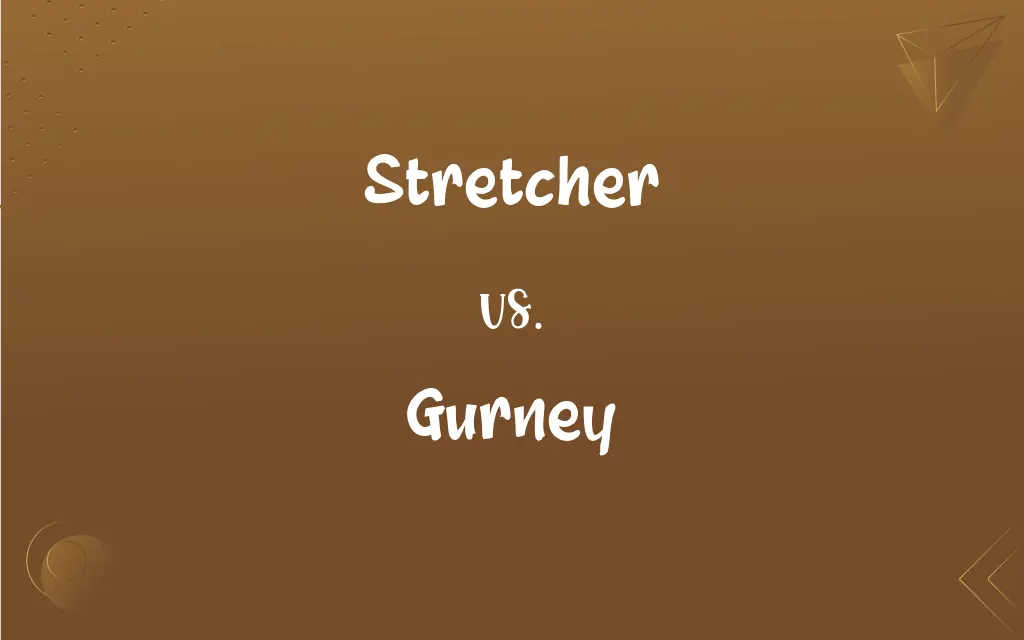Stretcher vs. Gurney: What's the Difference?
Edited by Aimie Carlson || By Janet White || Updated on June 13, 2024
A stretcher is a simple, often portable, frame used for transporting injured or sick people, while a gurney is a wheeled stretcher used in hospitals.

Key Differences
Stretcher and gurney are both medical equipment used for transporting individuals who are sick, injured, or incapacitated, yet they have their distinct features and uses. A stretcher is a basic apparatus, usually consisting of a flat or slightly concave surface, mounted on poles and often portable, designed to transport injured or sick people. In contrast, a gurney is more complex, typically featuring wheels, and is predominantly used within hospital settings for the transportation of patients between different sections of a healthcare facility.
The stretcher, being simple and portable, is commonly utilized in emergency medical situations, like on battlefields, sports fields, or at accident sites, allowing for quick and efficient movement of patients to medical facilities. Gurneys, on the other hand, being wheeled, facilitate smoother navigation within hospitals, especially through corridors and elevators, making them suitable for internal transportation of patients, including those who are bedridden or undergoing medical procedures.
The fundamental distinction between a stretcher and a gurney lies in their design and functionality. While stretchers are simplistic and primarily aimed at providing immediate support and conveyance of patients in various environments, gurneys are equipped with additional features such as adjustable heights and backrests, enabling enhanced comfort and positioning of patients, which is particularly advantageous during medical examinations and treatments.
Despite their differences, the terms stretcher and gurney are sometimes used interchangeably, particularly in informal communication, leading to some confusion. However, professionals in healthcare settings are more likely to use the term gurney when referring to the wheeled, adjustable apparatus and stretcher for the simpler, portable one. The context of usage, therefore, plays a significant role in determining the precise meaning of these terms.
In essence, while both stretcher and gurney serve the purpose of moving patients, the stretcher is more versatile and portable, making it suitable for emergency and outdoor usage, and the gurney, being wheeled and adjustable, is more suited for indoor, particularly hospital, environments, offering more comfort and convenience to the patients.
ADVERTISEMENT
Comparison Chart
Definition
A simple, often portable frame for transporting injured or sick people
A wheeled stretcher used predominantly in hospitals
Portability
Highly portable, used in various environments
Less portable, used mainly within hospitals
Features
Basic, with minimal features
More complex, often with adjustable heights and backrests
Common Usage
Emergency medical situations outside hospitals
Internal transportation of patients within hospitals
Adjustability
Usually non-adjustable
Typically adjustable to cater to patients’ comfort and medical requirements
ADVERTISEMENT
Stretcher and Gurney Definitions
Stretcher
A simple frame used for carrying injured or sick people.
The paramedics quickly placed the accident victim on a stretcher.
Gurney
A hospital apparatus with adjustable features for patient comfort.
The nurse adjusted the gurney to a reclining position for the patient’s comfort.
Stretcher
A device designed for transporting individuals who are incapacitated.
The injured player was carried off the field on a stretcher.
Gurney
A wheeled stretcher used for transporting patients in hospitals.
The patient was wheeled into the operating room on a gurney.
Stretcher
A flat or slightly concave surface mounted on poles for carrying patients.
The soldier was carried to the medical tent on a stretcher.
Gurney
A bed-like apparatus used for moving patients between different sections of a hospital.
The orderly pushed the gurney through the hospital corridors to the designated room.
Stretcher
A piece of equipment used in various environments for immediate support and conveyance of patients.
The medical team had a stretcher ready for any emergencies during the marathon.
Gurney
A movable hospital bed designed for convenience and comfort during medical examinations and treatments.
The doctor conducted a quick examination of the patient on the gurney before surgery.
Stretcher
A litter, usually of canvas stretched over a frame, used to transport the sick, wounded, or dead.
Gurney
A medical device used predominantly for internal transportation of patients.
The medical staff swiftly moved the patient on a gurney to the radiology department.
Stretcher
One that stretches, such as the wooden framework on which canvas is stretched for an oil painting.
Gurney
(US) A stretcher having wheeled legs.
Stretcher
A usually horizontal tie beam or brace serving to support or extend a framework.
Gurney
A metal stretcher with wheeled legs, used for transporting patients.
Stretcher
A brick or stone laid parallel to the face of a wall so that only its long side is showing.
Gurney
A metal stretcher with wheels
Stretcher
(Informal) An exaggerated or fabricated assertion or anecdote
"That book ... is mostly a true book, with some stretchers" (Mark Twain).
Stretcher
One who, or that which, stretches.
Stretcher
A simple litter designed to carry a sick, injured, or dead person.
Stretcher
A frame on which a canvas is stretched for painting.
Stretcher
A device to stretch shoes or gloves.
Stretcher
A brick laid with the longest side exposed (compare header).
Stretcher
(architecture) A piece of timber used in building.
Stretcher
(slang) A lie; an overstretching of the truth.
Stretcher
(nautical) A board against which a rower places his feet.
Stretcher
One of the rods in an umbrella, attached at one end to one of the ribs, and at the other to the tube sliding upon the handle.
Stretcher
(obsolete) A penis, especially a long penis.
Stretcher
(transitive) To carry (an injured person) on a stretcher.
Stretcher
One who, or that which, stretches.
Stretcher
A brick or stone laid with its longer dimension in the line of direction of the wall.
Stretcher
A piece of timber used in building.
Stretcher
A narrow crosspiece of the bottom of a boat against which a rower braces his feet.
Stretcher
A litter, or frame, for carrying disabled, wounded, or dead persons.
Stretcher
An overstretching of the truth; a lie.
Stretcher
One of the rods in an umbrella, attached at one end to one of the ribs, and at the other to the tube sliding upon the handle.
Stretcher
An instrument for stretching boots or gloves.
Stretcher
The frame upon which canvas is stretched for a painting.
Stretcher
A wooden framework on which canvas is stretched and fixed for oil painting
Stretcher
A mechanical device used to make something larger (as shoes or gloves) by stretching it
Stretcher
A litter for transporting people who are ill or wounded or dead; usually consists of a sheet of canvas stretched between two poles
Stretcher
A stone that forms the top of wall or building
Stretcher
A portable medical equipment used for emergency situations.
The rescue team used a stretcher to evacuate the injured hiker.
FAQs
Does a gurney have wheels?
Yes, a gurney typically has wheels and is used predominantly in hospitals for transporting patients.
Is a stretcher typically portable?
Yes, a stretcher is typically portable and designed for transporting injured or sick people efficiently.
Can a gurney be used in outdoor emergency situations?
Gurneys are primarily designed for indoor use, particularly within hospitals, due to their wheeled and adjustable nature.
Is a gurney more complex than a stretcher?
Yes, a gurney is more complex, often featuring adjustable heights and backrests for enhanced patient comfort.
Can a stretcher be used in emergency medical situations?
Yes, a stretcher is commonly used in emergency medical situations like accidents or on battlefields.
Are stretchers adjustable?
Typically, stretchers are non-adjustable, designed to provide immediate support and conveyance of patients.
Can a stretcher have a concave surface?
Yes, some stretchers have a flat or slightly concave surface to securely hold the patient during transport.
Are stretchers used on sports fields?
Yes, stretchers are often used on sports fields to quickly transport injured players to receive medical care.
Is the term stretcher used interchangeably with gurney?
The terms are sometimes used interchangeably in informal communication, but they have different meanings and uses.
Can a gurney be used for medical examinations?
Yes, a gurney, with its adjustable features, is suitable for medical examinations and treatments.
Can stretchers be used in military situations?
Yes, stretchers are widely used in military situations to transport injured soldiers from battlefields to medical facilities.
Are stretcher and gurney terms professionally distinct in healthcare settings?
Yes, in professional healthcare settings, the terms stretcher and gurney are distinct, with each representing a specific type of patient transport equipment.
Is a gurney suitable for moving bedridden patients within a hospital?
Absolutely, a gurney is designed to transport bedridden patients within hospitals smoothly and comfortably.
Can a gurney be used to transport patients to different hospital sections?
Yes, gurneys are utilized to transport patients between different sections of a hospital, like from wards to operating rooms.
Do gurneys have adjustable backrests?
Yes, many gurneys have adjustable backrests to cater to the comfort and medical requirements of patients.
About Author
Written by
Janet WhiteJanet White has been an esteemed writer and blogger for Difference Wiki. Holding a Master's degree in Science and Medical Journalism from the prestigious Boston University, she has consistently demonstrated her expertise and passion for her field. When she's not immersed in her work, Janet relishes her time exercising, delving into a good book, and cherishing moments with friends and family.
Edited by
Aimie CarlsonAimie Carlson, holding a master's degree in English literature, is a fervent English language enthusiast. She lends her writing talents to Difference Wiki, a prominent website that specializes in comparisons, offering readers insightful analyses that both captivate and inform.
































































